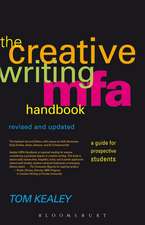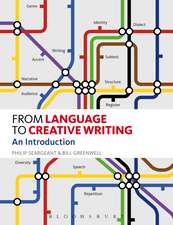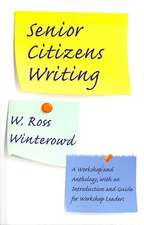Imaginative Teaching through Creative Writing: A Guide for Secondary Classrooms
Editat de Dr Amy Ash, Dr Michael Dean Clark, Teaching Assistant Chris Drewen Limba Engleză Hardback – 24 mar 2021
Preț: 570.02 lei
Preț vechi: 816.66 lei
-30% Nou
Puncte Express: 855
Preț estimativ în valută:
109.10€ • 113.47$ • 91.43£
109.10€ • 113.47$ • 91.43£
Carte tipărită la comandă
Livrare economică 14-28 martie
Preluare comenzi: 021 569.72.76
Specificații
ISBN-13: 9781350152687
ISBN-10: 1350152684
Pagini: 280
Ilustrații: 11 bw illus
Dimensiuni: 156 x 234 x 23 mm
Greutate: 0.57 kg
Editura: Bloomsbury Publishing
Colecția Bloomsbury Academic
Locul publicării:London, United Kingdom
ISBN-10: 1350152684
Pagini: 280
Ilustrații: 11 bw illus
Dimensiuni: 156 x 234 x 23 mm
Greutate: 0.57 kg
Editura: Bloomsbury Publishing
Colecția Bloomsbury Academic
Locul publicării:London, United Kingdom
Caracteristici
Includes articles from key scholars in the field of creative writing pedagogy including Michael Dean Clark, Trent Hergenrader and Stephanie Vanderslice.
Notă biografică
Amy Ash is an Assistant Professor of English at Indiana State University, USA and Director of the Indiana State University Creative Writing Program. She specializes in poetry and creative writing. The author of The Open Mouth of the Vase, winner of the 2013 Cider Press Review Book Award and the 2016 Etchings Press Whirling Prize post-publication award for poetry, her work has been published in various journals and anthologies. Michael Dean Clark is an Associate Professor of Writing at Azusa Pacific University, USA. An author of fiction and nonfiction primarily, his work has appeared in Pleiades, Jabberwock Review, The Other Journal, Angel City Review, and a number of other publications. Formerly an award-winning journalist, he is also the co-editor of Creative Writing in the Digital Age and Creative Writing Innovations (Bloomsbury, 2015). Chris Drew is an Associate Professor of English at Indiana State University, USA, where he specializes in creative writing and secondary English teaching methods. He is an editor of Dispatches from the Classroom: Graduate Students on Creative Writing Pedagogy (Bloomsbury, 2011). His creative work has been published in Bellevue Literary Review, Quarterly West, and Mad River Review. His scholarly articles have appeared in English Leadership Quarterly, Wisconsin English Journal, Minnesota English Journal, and The Journal of Creative Writing Studies.
Cuprins
List of FiguresList of TablesList of ContributorsForeword, Janelle Adsit, Humboldt State University, USAAcknowledgementsIntroductionPart One1. Finding Our Angels in Ourselves: Overcoming Lore and Myth to Teach Creative Writing, Stephanie Vanderslice, University of Central Arkansas, USA2. Creativity and "Common" Sense: The Standardization of Creative Writing in the Secondary Classroom, Chris Drew, Indiana State University, USA3. The Creative Writing Process: A View from the Classroom, Alexa Garvoille, Virginia Polytechnic Institute and State University, USA4. "Workshop" as Verb and Environment: Imagining New Possibilities and Approaches, Amy Ash, Indiana State University, USA5. Collaborative Worldbuilding: Bridging Critical Thinking and Creative Production, Trent Hergenrader, Rochester Institute of Technology, USA6. Our Hidden Prime Directive: How Classism Teaches People to Leave Spaceships and Wizards Out of the Classroom, Jennifer Pullen, Ohio Northern University, USA7. Break Stuff: The Necessity of Mistakes and the Risks that Cause Them in Creative Writing, Michael Dean Clark, Azusa Pacific University, USA8. Freedom in Limits: Using Demi-Rubrics to Evaluate Creative Work, John Belk, Southern Utah University, USAPart Two9. Creative Foundations: The Benefits of Prioritizing Creative Nonfiction in the Secondary Standards-Based Classroom, Sara C. Pendleton, Grace Brethren Senior High School, USA10. Unruining Poetry, Tim Staley, Oñate High School, USA11. The Poetry of Math and Science, Kelli Krieger, Union-Endicott Central School District, USA12. Making Writers Out of Readers: Using Creative Writing to Deepen Literary Analysis in Secondary Settings, Heather J. Clark, Covina Unified School District, USA1. Responsive Freedom: Creative Writing in the Advanced Placement English Literature and Composition Classroom, Amanda Clarke and Nan Cohen, Viewpoint School, USA14. From Queen to Court Jester: Writing Multigenre Papers alongside My Students, Oona Marie Abrams, Chatham High School, USA15. Crafting Online Story Worlds as Literary Response, Stacy Haynes-Moore, The University of Iowa and the Cedar Rapids Community School District, USA16. Capturing Flash Fiction: Utilizing Graphics, Family, and Friends to Engage ELL Students, Mark Esperanza, Northwest Vista College and Northside Independent School District, USA17. Yours, Mine, Ours: Collaboration and Differentiated Learning in the Creative Writing Classroom, Tanya Perkins and Josh Tolbert, Indiana University East, USA18. NaNoWriMo and Young Writers: Using a Novel Approach to Push Students' Writing, Erik Burgeson and Tom Strous, Worthington City School District, USA19. Beyond Brick Walls and Computer Screens: The Story of a University/Middle School Writing Partnership, Dana VanderLugt, Hudsonville Public Schools, USA and Erica Hamilton, Grand Valley State University, USA20. Beyond the Desk: Fostering Community Engagement through Authentic Writing Experiences In and Out of the Classroom, Justin Longacre, Toledo School for the Arts, USAAppendixIndex
Recenzii
Contributors to this volume prove beyond any doubt that creative writing belongs in the secondary classroom, offering research-based conceptual groundwork and mapping standards for inspiring activities and practices, presented by the teachers who developed them ... Secondary teachers will find both inspiration for developing assignments and a solid theoretical framework for scaffolding, assessing, and reporting about them to administrators.
Imaginative Teaching is a teacher's book. It is for and about teaching and learning led by voices both dynamic and inspired. I dare you to read it. Because you can't just read it; you will write and think beside it for days. Your classroom will be upended by the smart thinking here. And that's important, because sometimes changing students' learning outcomes requires a major shift in teacher culture-our culture. But that is the gift of this book: an invitation to experience the joy and expansive thinking that these classroom teachers have realized in courses labeled AP to remedial. As poet and teacher Tim Staley says in a chapter I wish I had written, "Poetry should be a break from the typical horrors of high school." Reading, writing, and teaching can be. Imaginative Teaching shows us the moves that will create a home for creative writing in our plans, our notebooks, and forever, in our students.
Imaginative Teaching is a teacher's book. It is for and about teaching and learning led by voices both dynamic and inspired. I dare you to read it. Because you can't just read it; you will write and think beside it for days. Your classroom will be upended by the smart thinking here. And that's important, because sometimes changing students' learning outcomes requires a major shift in teacher culture-our culture. But that is the gift of this book: an invitation to experience the joy and expansive thinking that these classroom teachers have realized in courses labeled AP to remedial. As poet and teacher Tim Staley says in a chapter I wish I had written, "Poetry should be a break from the typical horrors of high school." Reading, writing, and teaching can be. Imaginative Teaching shows us the moves that will create a home for creative writing in our plans, our notebooks, and forever, in our students.





















